Global N-linked Glycosylation is Not Significantly Impaired in Myoblasts in Congenital Myasthenic Syndromes Caused by Defective Glutamine-Fructose-6-Phosphate Transaminase 1 (GFPT1)
Abstract
:1. Introduction
2. Results and Discussion
2.1. Optimisation of Myoblast Culture Conditions
2.2. Glycomic Analysis of Patient and Control Myoblasts Reveals no Impairment in N-Glycosylation
 GlcNAc,
GlcNAc,  Man,
Man,  Gal,
Gal,  Fuc,
Fuc,  NeuAc.
NeuAc.
 GlcNAc,
GlcNAc,  Man,
Man,  Gal,
Gal,  Fuc,
Fuc,  NeuAc.
NeuAc.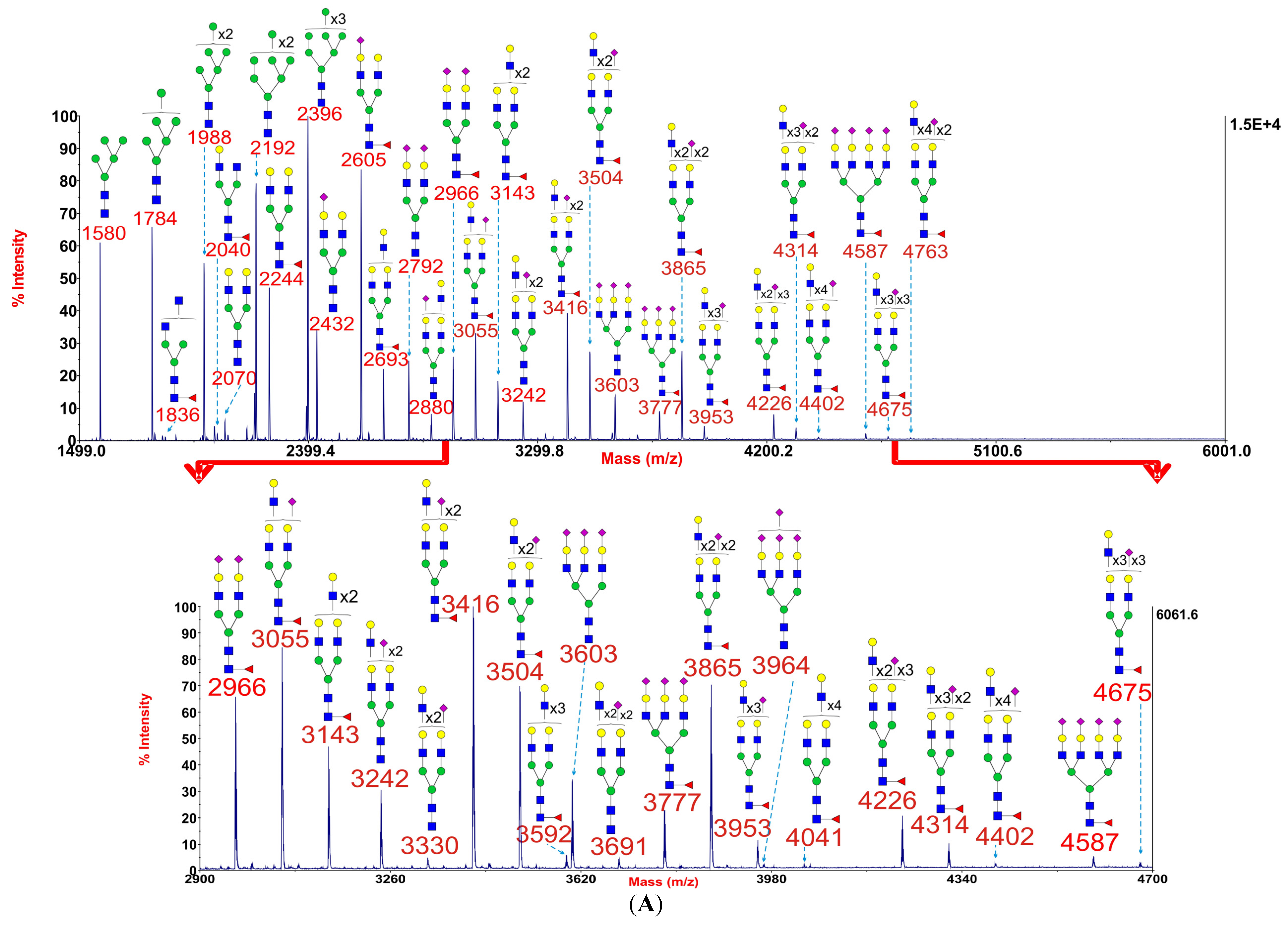
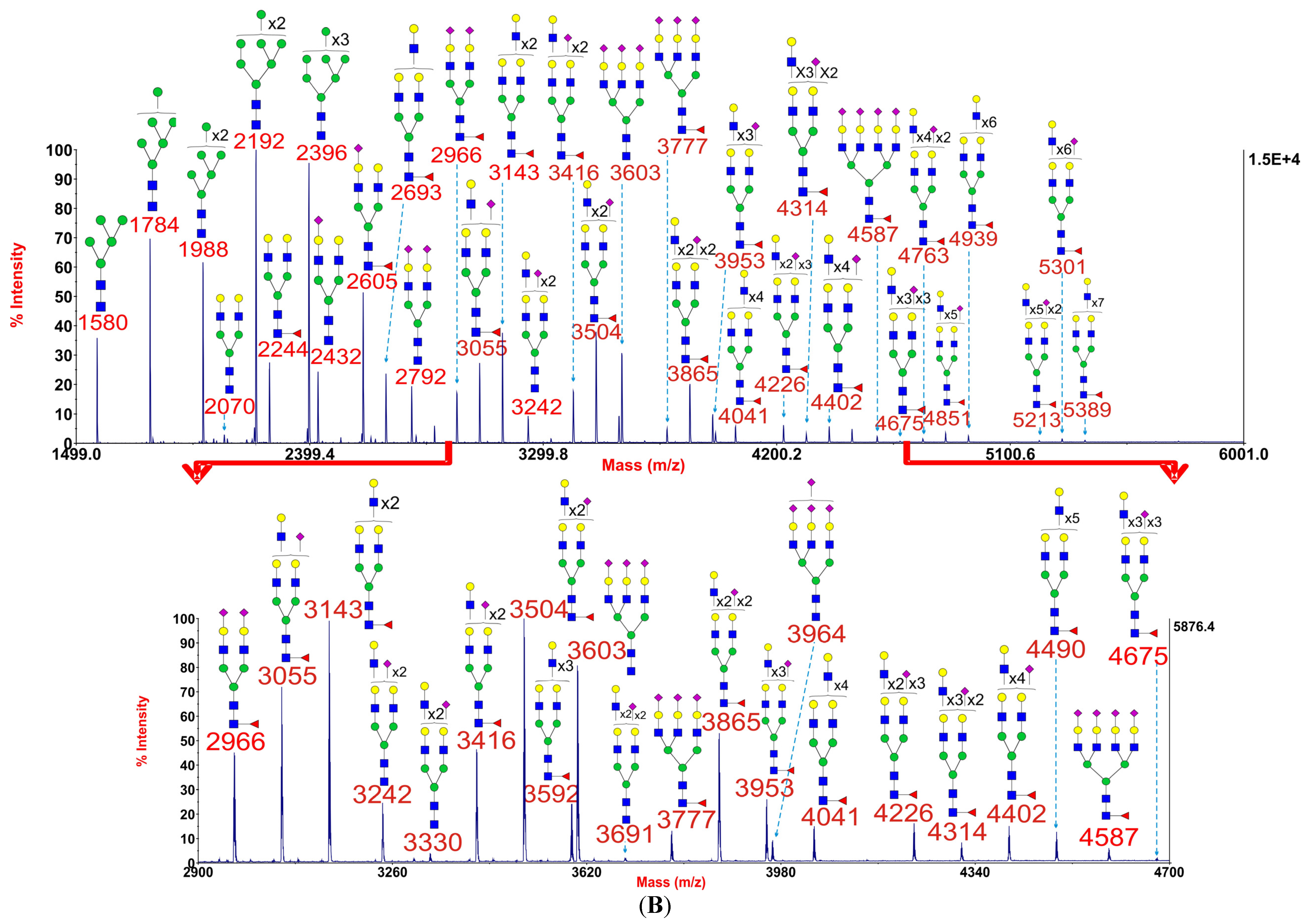
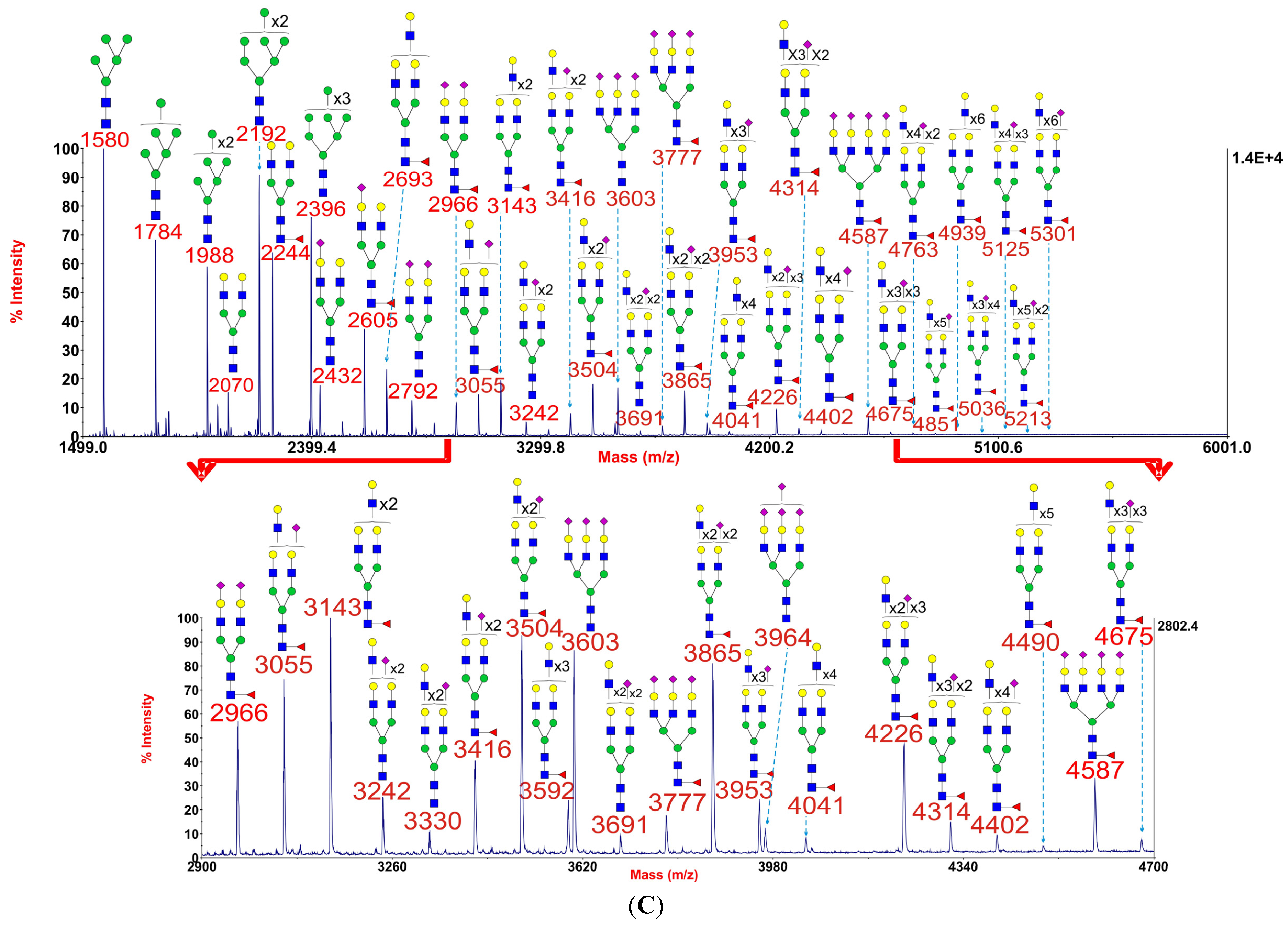

2.3. Sialic Acid Linkages Are Predominantly α2-3 in Myoblasts
 GlcNAc,
GlcNAc,  Man,
Man,  Gal,
Gal,  Fuc,
Fuc,  NeuAc.
NeuAc.
 GlcNAc,
GlcNAc,  Man,
Man,  Gal,
Gal,  Fuc,
Fuc,  NeuAc.
NeuAc.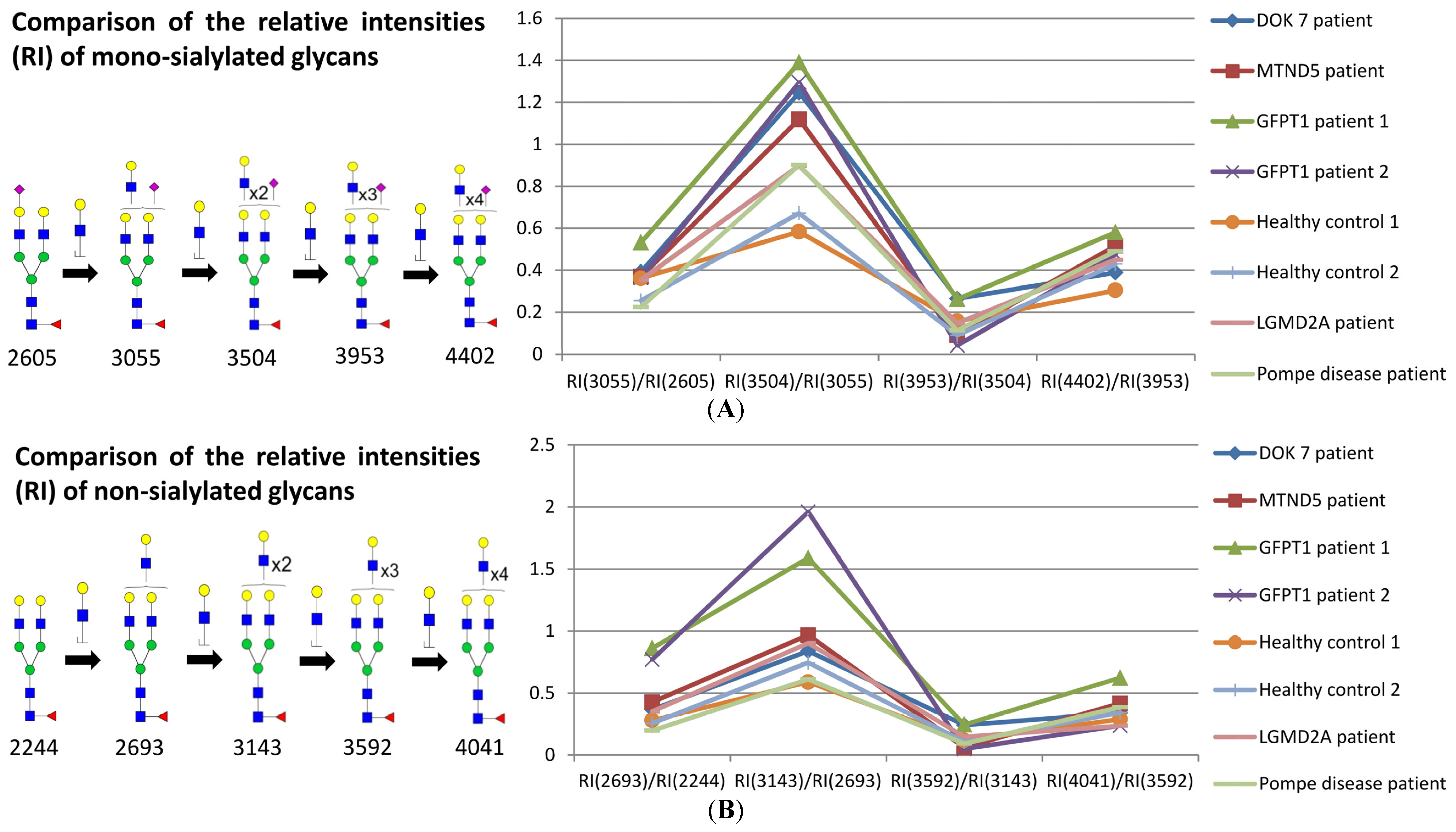
 GlcNAc,
GlcNAc,  Man,
Man,  Gal,
Gal,  Fuc,
Fuc,  NeuAc.
NeuAc.
 GlcNAc,
GlcNAc,  Man,
Man,  Gal,
Gal,  Fuc,
Fuc,  NeuAc.
NeuAc.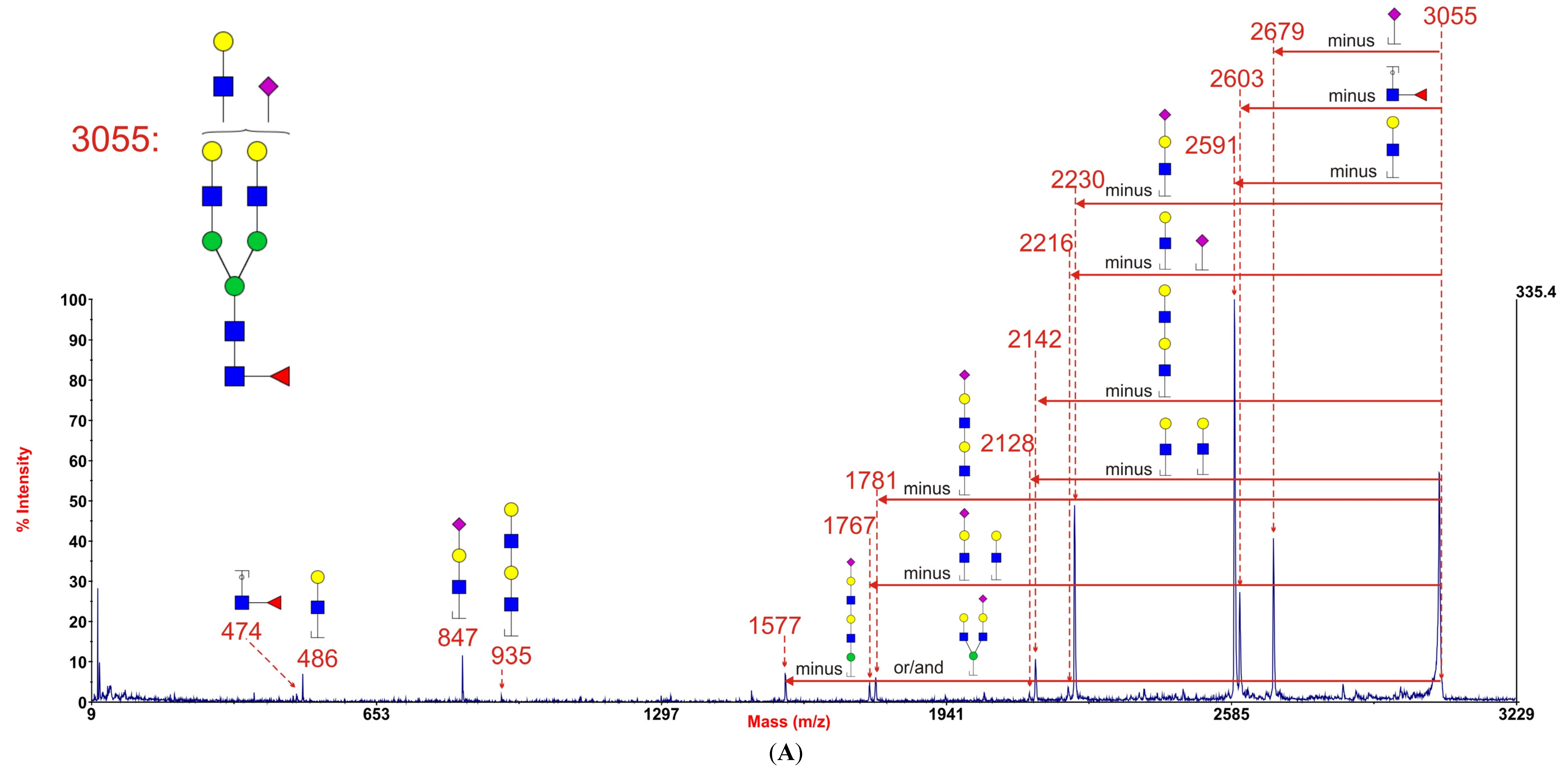
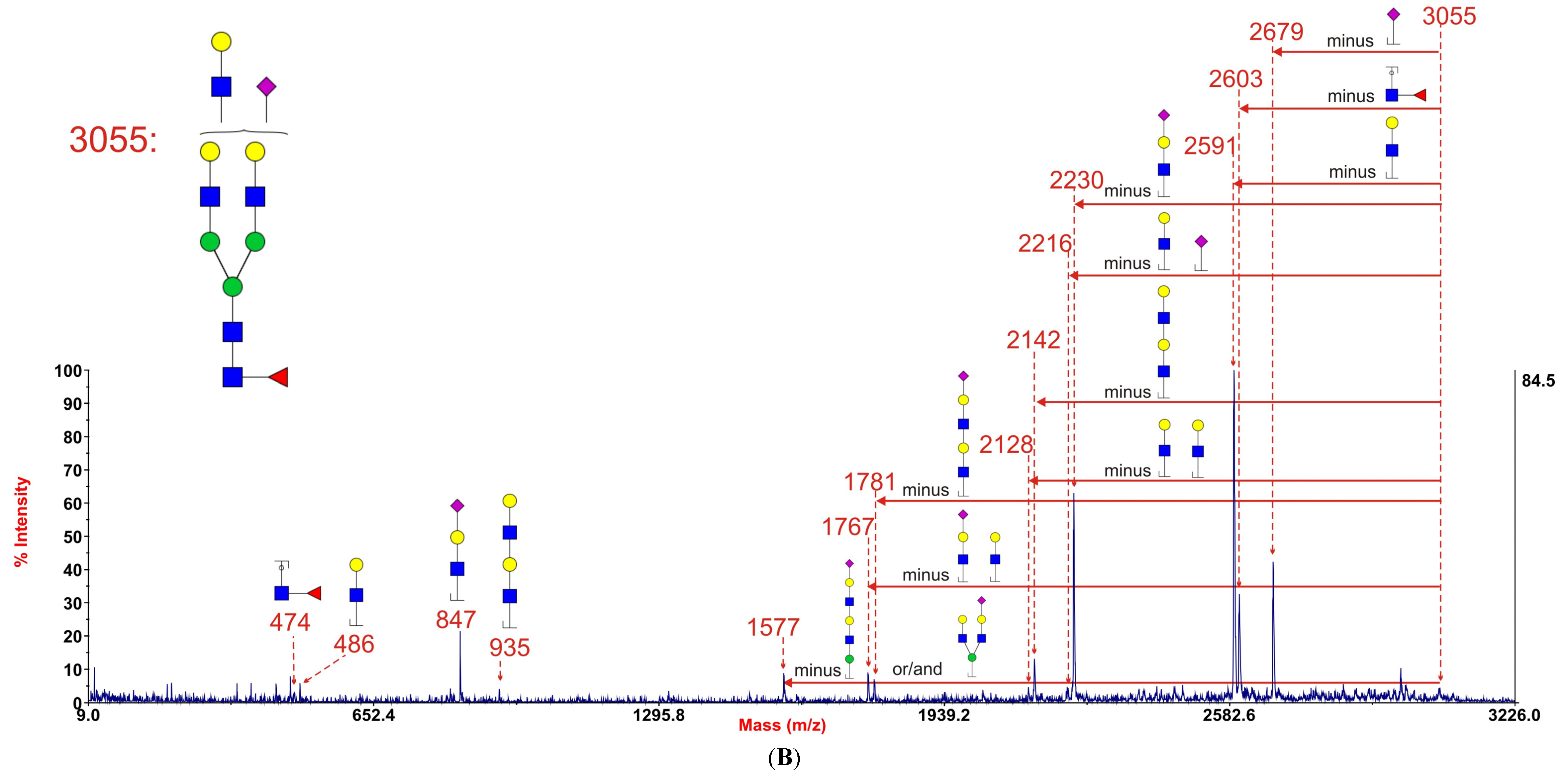
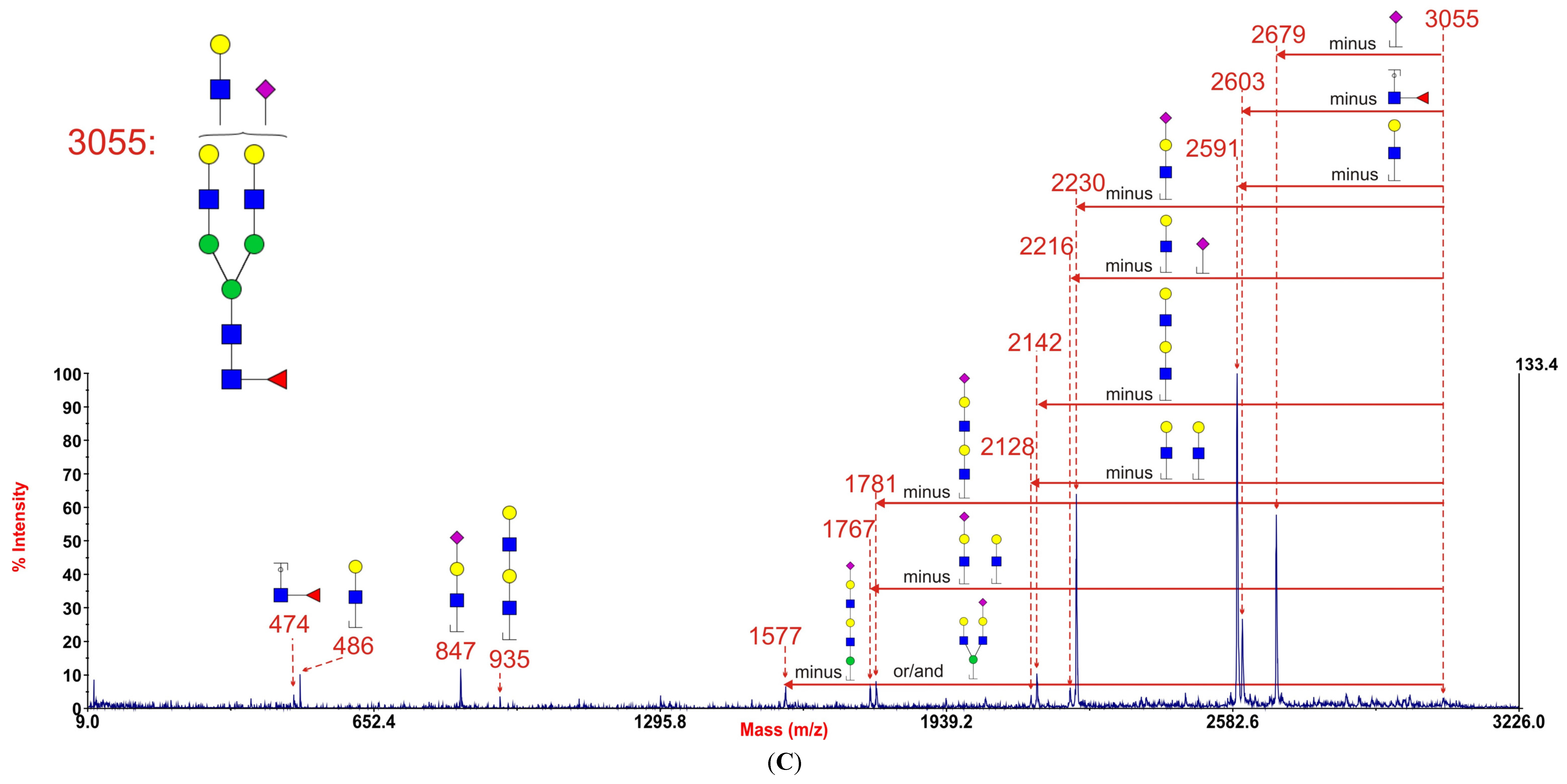
 GlcNAc,
GlcNAc,  Man,
Man,  Gal,
Gal,  Fuc,
Fuc,  NeuAc.
NeuAc.
 GlcNAc,
GlcNAc,  Man,
Man,  Gal,
Gal,  Fuc,
Fuc,  NeuAc.
NeuAc.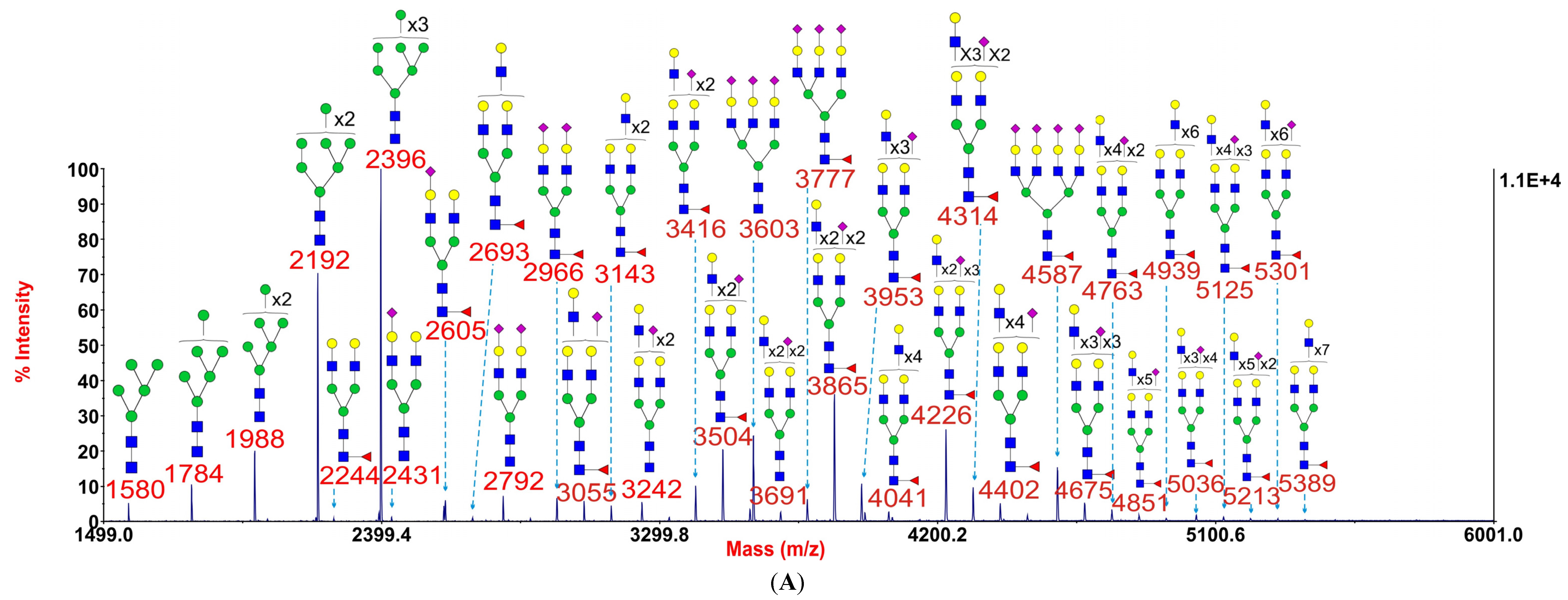

2.4. Glycomic Analysis of Patient and Control Myotubes Reveals no Significant Difference in N-glycosylation
2.5. Discussion
 GlcNAc,
GlcNAc,  Man,
Man,  Gal,
Gal,  Fuc,
Fuc,  NeuAc.
NeuAc.
 GlcNAc,
GlcNAc,  Man,
Man,  Gal,
Gal,  Fuc,
Fuc,  NeuAc.
NeuAc.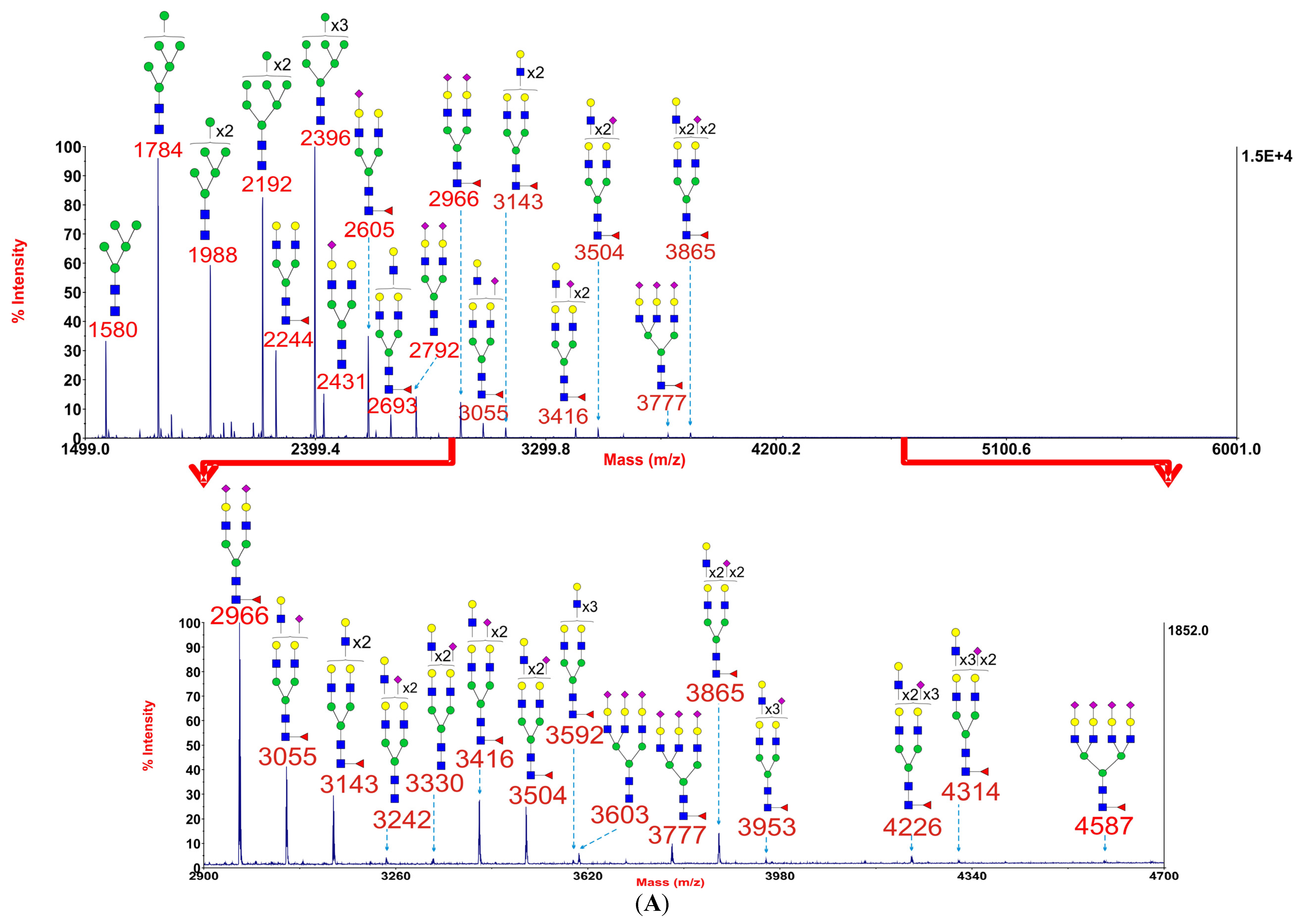
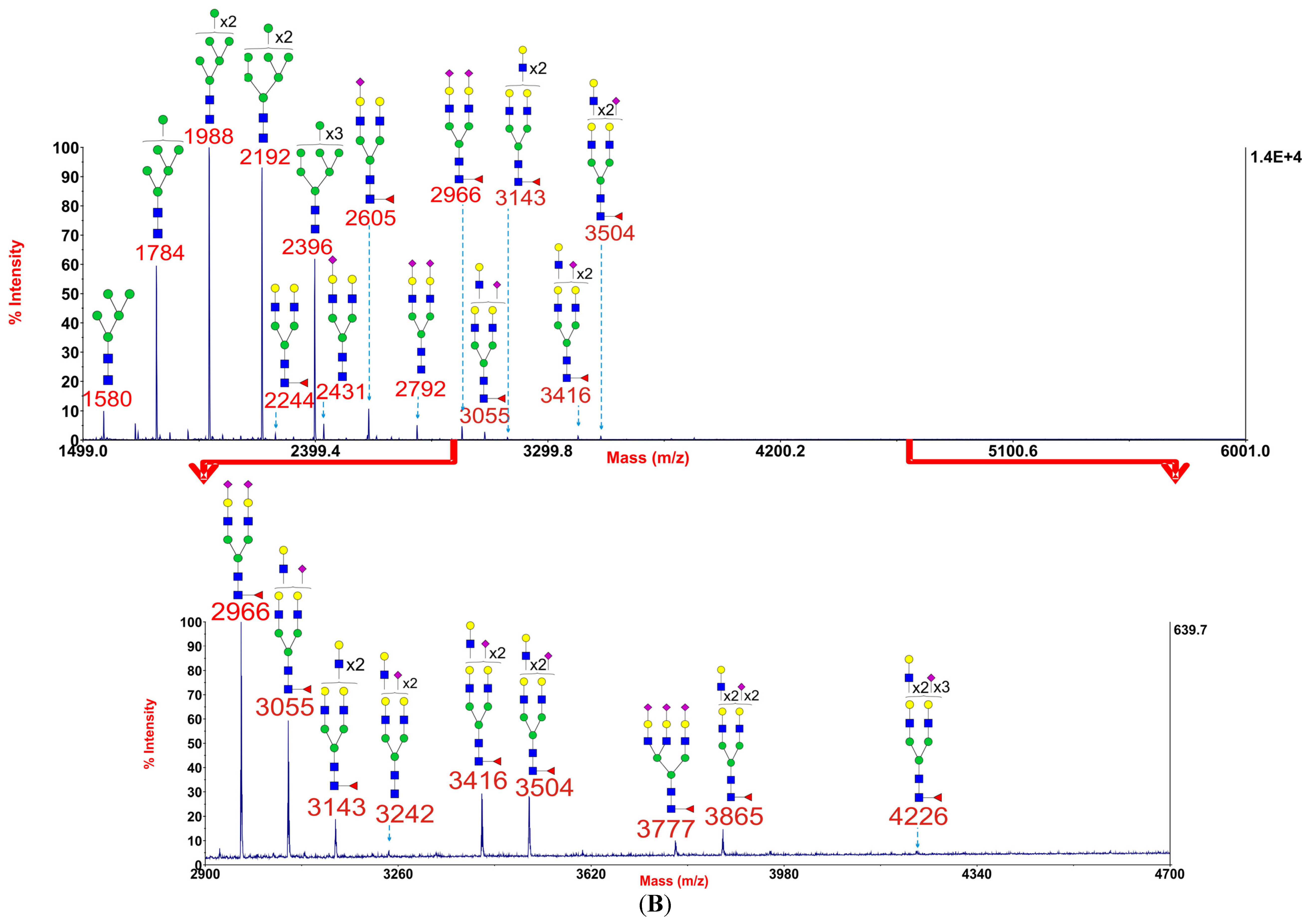
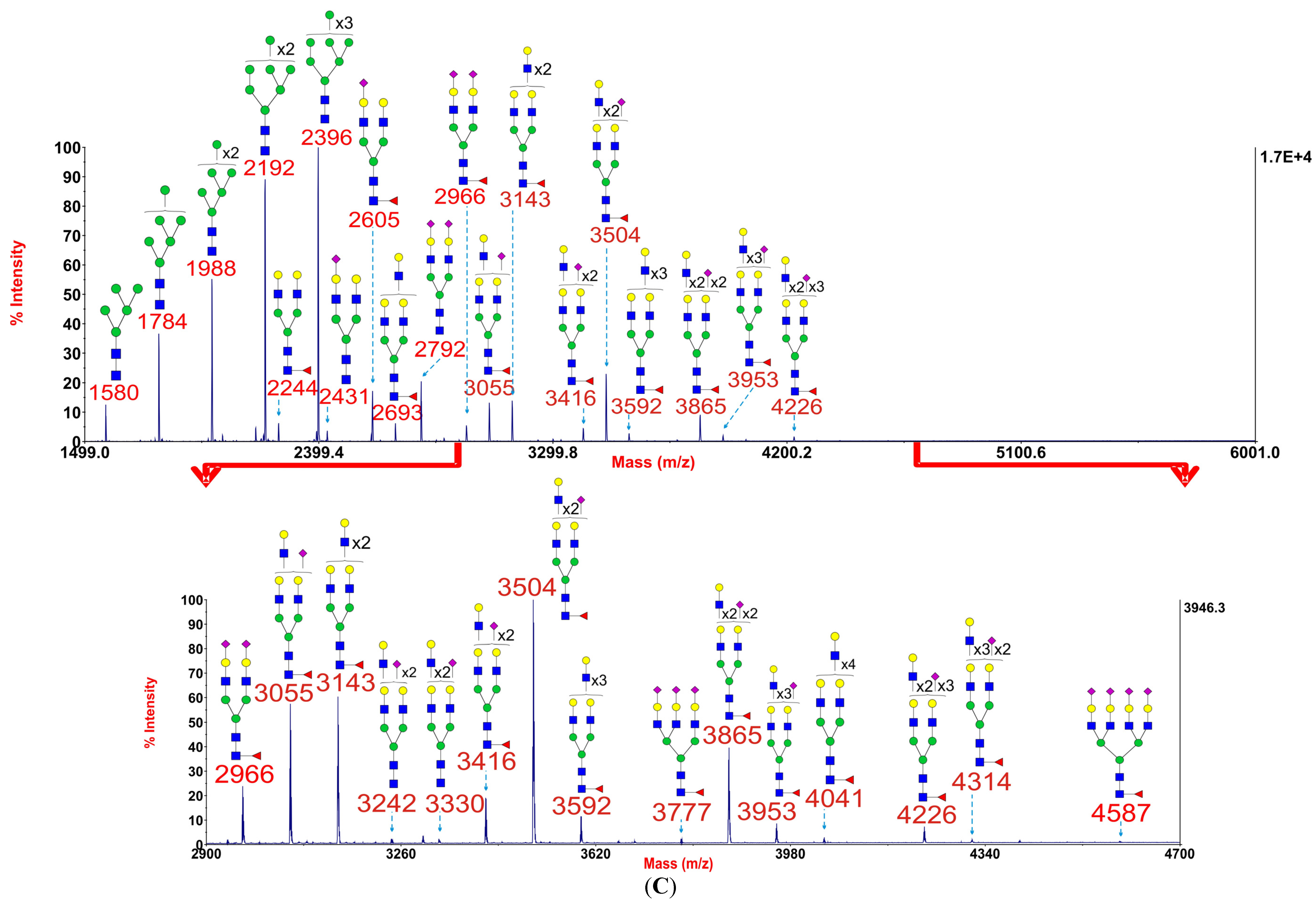
3. Materials and Methods
3.1. Patients
3.2. Cell Culture
3.3. Processing of Myoblasts and Myotubes to Acquire N- and O-glycans
3.4. Mass Spectrometric Glycomic Analysis
3.5. Analyses of MALDI Data
4. Conclusions
Supplementary Files
Supplementary File 1Acknowledgment
Author Contributions
Conflicts of Interest
References
- Senderek, J.; Muller, J.S.; Dusl, M.; Strom, T.M.; Guergueltcheva, V.; Diepolder, I.; Laval, S.H.; Maxwell, S.; Cossins, J.; Krause, S.; et al. Hexosamine biosynthetic pathway mutations cause neuromuscular transmission defect. Am. J. Hum. Genet. 2011, 88, 162–172. [Google Scholar] [CrossRef] [PubMed]
- Guergueltcheva, V.; Muller, J.S.; Dusl, M.; Senderek, J.; Oldfors, A.; Lindbergh, C.; Maxwell, S.; Colomer, J.; Mallebrera, C.J.; Nascimento, A.; et al. Congenital myasthenic syndrome with tubular aggregates caused by GFPT1 mutations. J. Neurol. 2011, 259, 838–850. [Google Scholar] [CrossRef] [PubMed]
- Belaya, K.; Finlayson, S.; Slater, C.R.; Cossins, J.; Liu, W.W.; Maxwell, S.; McGowan, S.J.; Maslau, S.; Twigg, S.R.; Walls, T.J.; et al. Mutations in DPAGT1 cause a limb-girdle congenital myasthenic syndrome with tubular aggregates. Am. J. Hum. Genet. 2012, 91, 193–201. [Google Scholar] [CrossRef] [PubMed]
- Cossins, J.; Belaya, K.; Hicks, D.; Salih, M.A.; Finlayson, S.; Carboni, N.; Liu, W.W.; Maxwell, S.; Zoltowska, K.; Farsani, G.T.; et al. Congenital myasthenic syndromes due to mutations in ALG2 and ALG14. Brain 2013, 136, 944–956. [Google Scholar] [CrossRef] [PubMed]
- Monk, C.R.; Sutton-Smith, M.; Dell, A.; Garden, O.A. Preparation of CD25(+) and CD25(−) CD4(+) T cells for glycomic analysis—A cautionary tale of serum glycoprotein sequestration. Glycobiology 2006, 16, 11G–13G. [Google Scholar] [CrossRef] [PubMed]
- Dell, A.; Morris, H.R. Glycoprotein structure determination mass spectrometry. Science 2001, 291, 2351–2356. [Google Scholar] [CrossRef] [PubMed]
- Antonopoulos, A.; Demotte, N.; Stroobant, V.; Haslam, S.M.; van der Bruggen, P.; Dell, A. Loss of effector function of human cytolytic T lymphocytes is accompanied by major alterations in N- and O-glycosylation. J. Biol. Chem. 2012, 287, 11240–11251. [Google Scholar] [CrossRef] [PubMed]
- Sassi, A.; Lazaroski, S.; Wu, G.; Haslam, S.M.; Fliegauf, M.; Mellouli, F.; Patiroglu, T.; Unal, E.; Ozdemir, M.A.; Jouhadi, Z.; et al. Hypomorphic homozygous mutations in phosphoglucomutase 3 (PGM3) impair immunity and increase serum IGE levels. J. Allergy Clin. Immunol. 2014. [Google Scholar] [CrossRef] [PubMed]
- Schleicher, E.D.; Weigert, C. Role of the hexosamine biosynthetic pathway in diabetic nephropathy. Kidney Int. Suppl. 2000, 77, S13–S18. [Google Scholar] [CrossRef] [PubMed]
- Zoltowska, K.; Webster, R.; Finlayson, S.; Maxwell, S.; Cossins, J.; Muller, J.; Lochmuller, H.; Beeson, D. Mutations in GFPT1 that underlie limb-girdle congenital myasthenic syndrome result in reduced cell-surface expression of muscle AChR. Hum. Mol. Genet. 2013, 22, 2905–2913. [Google Scholar] [CrossRef] [PubMed]
- Freeze, H.H.; Eklund, E.A.; Ng, B.G.; Patterson, M.C. Neurological aspects of human glycosylation disorders. Annu. Rev. Neurosci. 2015, 38, 105–125. [Google Scholar] [CrossRef] [PubMed]
- Raval, K.K.; Tao, R.; White, B.E.; de Lange, W.J.; Koonce, C.H.; Yu, J.; Kishnani, P.S.; Thomson, J.A.; Mosher, D.F.; Ralphe, J.C.; et al. Pompe disease results in a GOLGI-based glycosylation deficit in human induced pluripotent stem cell-derived cardiomyocytes. J. Biol. Chem. 2015, 290, 3121–3136. [Google Scholar] [CrossRef] [PubMed]
- Lochmuller, H.; Johns, T.; Shoubridge, E.A. Expression of the E6 and E7 genes of human papillomavirus (HPV16) extends the life span of human myoblasts. Exp. Cell Res. 1999, 248, 186–193. [Google Scholar] [CrossRef] [PubMed]
- Jang-Lee, J.; North, S.J.; Sutton-Smith, M.; Goldberg, D.; Panico, M.; Morris, H.; Haslam, S.; Dell, A. Glycomic profiling of cells and tissues by mass spectrometry: Fingerprinting and sequencing methodologies. Methods Enzymol. 2006, 415, 59–86. [Google Scholar] [PubMed]
- Ceroni, A.; Maass, K.; Geyer, H.; Geyer, R.; Dell, A.; Haslam, S.M. Glycoworkbench: A tool for the computer-assisted annotation of mass spectra of glycans. J. Proteome Res. 2008, 7, 1650–1659. [Google Scholar] [CrossRef] [PubMed]
- Schachter, H. The “yellow brick road” to branched complex N-glycans. Glycobiology 1991, 1, 453–461. [Google Scholar] [CrossRef] [PubMed]
- North, S.J.; Jang-Lee, J.; Harrison, R.; Canis, K.; Ismail, M.N.; Trollope, A.; Antonopoulos, A.; Pang, P.C.; Grassi, P.; Al-Chalabi, S.; et al. Mass spectrometric analysis of mutant mice. Methods Enzymol. 2010, 478, 27–77. [Google Scholar] [PubMed]
© 2015 by the authors; licensee MDPI, Basel, Switzerland. This article is an open access article distributed under the terms and conditions of the Creative Commons Attribution license (http://creativecommons.org/licenses/by/4.0/).
Share and Cite
Chen, Q.; Müller, J.S.; Pang, P.-C.; Laval, S.H.; Haslam, S.M.; Lochmüller, H.; Dell, A. Global N-linked Glycosylation is Not Significantly Impaired in Myoblasts in Congenital Myasthenic Syndromes Caused by Defective Glutamine-Fructose-6-Phosphate Transaminase 1 (GFPT1). Biomolecules 2015, 5, 2758-2781. https://doi.org/10.3390/biom5042758
Chen Q, Müller JS, Pang P-C, Laval SH, Haslam SM, Lochmüller H, Dell A. Global N-linked Glycosylation is Not Significantly Impaired in Myoblasts in Congenital Myasthenic Syndromes Caused by Defective Glutamine-Fructose-6-Phosphate Transaminase 1 (GFPT1). Biomolecules. 2015; 5(4):2758-2781. https://doi.org/10.3390/biom5042758
Chicago/Turabian StyleChen, Qiushi, Juliane S. Müller, Poh-Choo Pang, Steve H. Laval, Stuart M. Haslam, Hanns Lochmüller, and Anne Dell. 2015. "Global N-linked Glycosylation is Not Significantly Impaired in Myoblasts in Congenital Myasthenic Syndromes Caused by Defective Glutamine-Fructose-6-Phosphate Transaminase 1 (GFPT1)" Biomolecules 5, no. 4: 2758-2781. https://doi.org/10.3390/biom5042758




